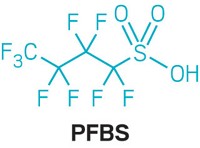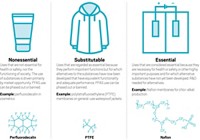Advertisement
Grab your lab coat. Let's get started
Welcome!
Welcome!
Create an account below to get 6 C&EN articles per month, receive newsletters and more - all free.
It seems this is your first time logging in online. Please enter the following information to continue.
As an ACS member you automatically get access to this site. All we need is few more details to create your reading experience.
Not you? Sign in with a different account.
Not you? Sign in with a different account.
ERROR 1
ERROR 1
ERROR 2
ERROR 2
ERROR 2
ERROR 2
ERROR 2
Password and Confirm password must match.
If you have an ACS member number, please enter it here so we can link this account to your membership. (optional)
ERROR 2
ACS values your privacy. By submitting your information, you are gaining access to C&EN and subscribing to our weekly newsletter. We use the information you provide to make your reading experience better, and we will never sell your data to third party members.
Environment
Fluoropolymers don’t deserve “low concern” label, researchers say
PFAS releases during production, use, and disposal contribute to materials’ impacts
by Cheryl Hogue
October 14, 2020
| A version of this story appeared in
Volume 98, Issue 40

The industry-backed conclusion that fluoropolymers pose low concern of risk to human health and the environment lacks scientific rationale, say researchers from Europe and the US (Environ. Sci. Technol. 2020, DOI: 10.1021/acs.est.0c03244)
Fluoropolymers such as widely used polytetrafluoroethylene—formerly branded as Teflon—“are large, stable, inert polymeric molecules that are too large to cross biological membranes,” says the Performance Fluoropolymer Partnership in a statement. The group represents the companies around the world that manufacture, formulate, or process fluoropolymers. These materials don’t present a significant concern for human health or the environment and meet the criteria for “polymers of low concern” set by the Organization for Economic Cooperation and Development, the industry partnership says.
Earning the designation as a polymer of low concern “can lead to exemptions from regulatory requirements in some jurisdictions,” Rainer Lohmann, the lead author of the new paper, says in a news release. Lohmann, an environmental chemist, is a professor of oceanography at the University of Rhode Island.
Lohmann and 12 other researchers evaluated evidence about the impacts of fluoropolymers throughout their lifecycles to determine if these materials merit designation as polymers of low concern. They found a high likelihood of human and environmental exposure to toxic nonpolymeric per- and polyfluoroalkyl substances (PFAS) released during the production, use, and disposal of fluoropolymers. These include PFAS processing aids and byproducts as well as PFAS that can leach from fluoropolymers.
The authors urge industry to move toward closed-loop systems that rely on discarded fluoropolymers as raw materials for new ones. They also call for manufacturers and industrial users to eliminate releases of PFAS from all stages of fluoropolymers’ lifecycles. If that is not possible, fluoropolymers should be restricted to uses considered essential for health, safety, and the functioning of society.
The Performance Fluoropolymer Partnership says it opposes the concepts of essential or nonessential uses “to justify restrictions for fluoropolymers, given their safety profiles, their high societal value, and the lack of alternatives that possess the same suite of performance characteristics.”





Join the conversation
Contact the reporter
Submit a Letter to the Editor for publication
Engage with us on Twitter